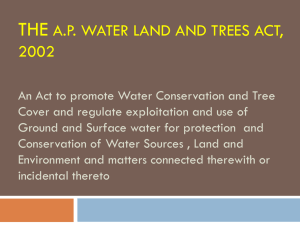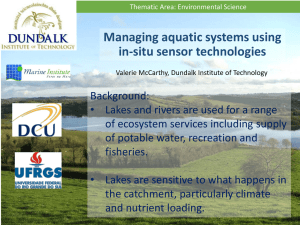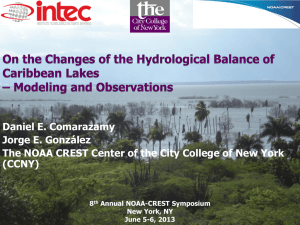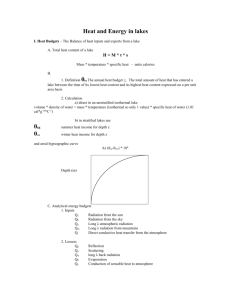grl52470-sup-0001-supplementary
advertisement
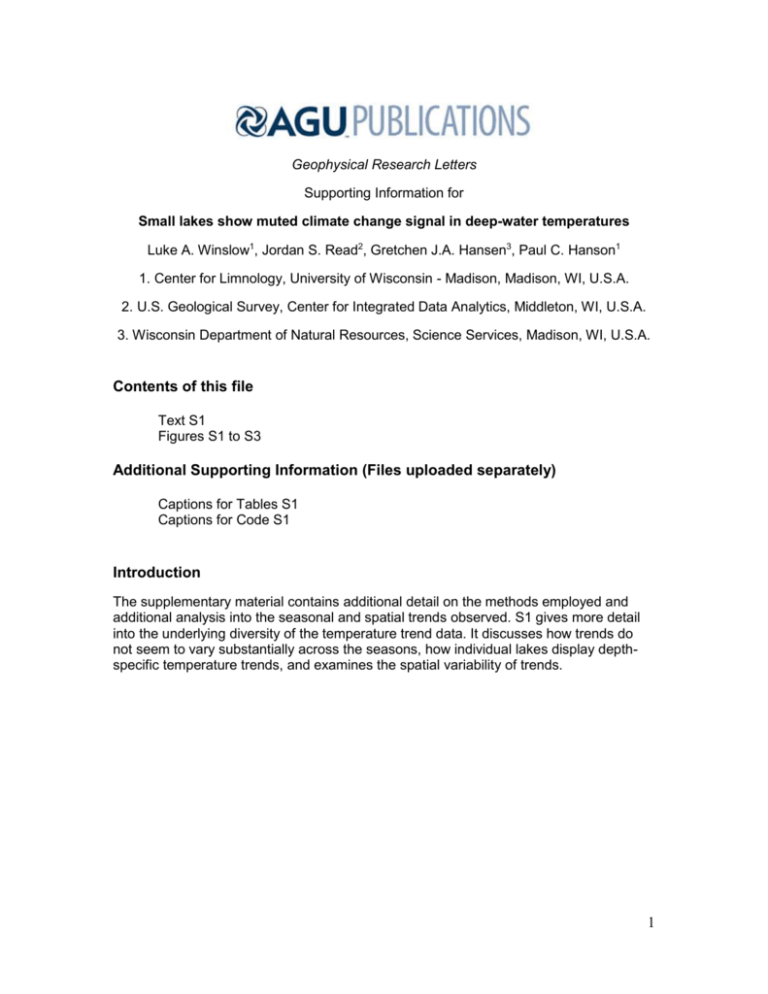
Geophysical Research Letters Supporting Information for Small lakes show muted climate change signal in deep-water temperatures Luke A. Winslow1, Jordan S. Read2, Gretchen J.A. Hansen3, Paul C. Hanson1 1. Center for Limnology, University of Wisconsin - Madison, Madison, WI, U.S.A. 2. U.S. Geological Survey, Center for Integrated Data Analytics, Middleton, WI, U.S.A. 3. Wisconsin Department of Natural Resources, Science Services, Madison, WI, U.S.A. Contents of this file Text S1 Figures S1 to S3 Additional Supporting Information (Files uploaded separately) Captions for Tables S1 Captions for Code S1 Introduction The supplementary material contains additional detail on the methods employed and additional analysis into the seasonal and spatial trends observed. S1 gives more detail into the underlying diversity of the temperature trend data. It discusses how trends do not seem to vary substantially across the seasons, how individual lakes display depthspecific temperature trends, and examines the spatial variability of trends. 1 Text S1. Temperature trends across seasons While the focus of this manuscript is on a broad-scale examination of water temperature trends in lakes, the variability of individual lake responses and how temperature trends may differ seasonally are important to consider. This variability is of interest from a mechanistic perspective, and also in how it may affect the performance of the cross-site, seasonal Sen’s slope method. Here, we present further exploration into the seasonal and cross-site patterns of temperature trends in Wisconsin lakes. 1.1 Seasonal Trends As seasonal Sen’s slope can be affected by seasonal differences in trends [Hirsch et al., 1982], we examined our dataset to see if seasonality in trends could introduce bias into the overall results. We plotted trends grouped by week of the year (Figure S2 and found no discernable seasonal pattern in trend. The large uncertainties and extreme values in the early and late year trends are likely due to the small number of observations in these seasons and should be ignored. Throughout the rest of the year, there is no clear season or month with clearly different trends that would affect the overall results presented. Further work is required to understand the specific drivers of the temperature trends and why they are so seasonally consistent. Cross-lake Trends The analysis presented in this manuscript aggregates observations from a large number of lakes to focus on broad-scale, cross-lake pattern and does not focus on patterns in any individual lake. Despite the broad-scale focus, showing individual-lake trends and 2 presenting detail on a small number of well-studied lakes helps present the pattern seen at the broad scale. Calculating lake-specific trends for all 142 lakes is challenged by the heterogeneous nature of the dataset. While some of the lakes are very consistently sampled throughout the season, others have observations for only one or two times in the year. These lakes with low numbers of observation yielded highly variable median trends. Figure S1 shows a map of the lakes in the analysis and uses color to indicate median overall temperature trend. Lake specific trends were highly variable (25% and 75% quantiles: -0.027 and 0.187) and included lakes with both positive and negative trends. The 39 lakes with large numbers of observations (large circles) showed more constrained lake-specific trends (25% and 75% quantiles: 0.006 and 0.1 °C yr-1) than all 142 lakes, though the median trend was the same for both groups. This large variability in lakespecific trends shows how the cross-site seasonal Sen’s slope method allowed us to use more of the dataset for the overall trend analysis than would have been possible if trends were calculated at the individual lake scale. Figure S3 shows the depth-specific trends for three lakes with almost three decades of consistently sampled and calibrated water temperature data from the North Temperate Lakes Long Term Ecological Research group. In the two large-lake examples (Figure S3a-b), the median temperature change is consistent across depths, with an overall median value of 0.046 °C yr-1 for Trout Lake (a) and 0.05 °C yr-1 for Sparkling Lake (b). For the lake under 0.5 km2, Crystal Lake (c), the trend was similar in the surface waters, changing towards a trend of 0 between depths of 9 to 12 meters. Overall median trend of Crystal lake is 0.018 °C yr-1, though this value is the combination of the 3 steeper trends in shallow waters and near-zero trends in deep waters. Splitting the lake into shallow and deep waters, the median trend for shallow depths (< 9m) and for deep depths (> 12m) are 0.05 and 0 °C yr-1 respectively. The deviation in trend in Sparkling lake (Figure S3b) between depths of 7 to 10 meters corresponds with the generally observed thermocline depth and may indicate a deepening trend in upper mixed layer of the lake, though we did not explore it in detail. References Hirsch, R. M., J. R. Slack, and R. a. Smith (1982), Techniques of trend analysis for monthly water quality data, Water Resour. Res., 18(1), 107–121, doi:10.1029/WR018i001p00107. 4 Figure S1: Map of lake-specific temperature trends for all lakes in the Wisconsin dataset. Filled points are lakes with significant trends at the 95% level as calculated per Hirsch et al., [1982]. Large points are lakes with more observations (greater than 3,000 paired-sample slopes) for which lake-specific trends had less uncertainty. 5 Figure S2: Median paired-value slopes grouped by the week of the year. Lines show 95% confidence intervals calculated using the method described by [Hirsch et al., 1982].The winter and late fall edges of the year have fewer observations and show higher variability in the medians. 6 Figure S3: Median paired-sample slope trends grouped by absolute depth for three exemplar lakes. (a) Shows trends from Trout Lake (area: 15.6 km2, average Secchi: 4.7 m), (b) Sparkling Lake (area: 0.6 km2, average Secchi: 6.2 m) and (c) Crystal Lake (area: 0.4 km2, average Secchi: 7.5 m). All lakes are from the North Temperate Lakes, Long-Term Ecological Research site, are in close proximity (within 20 km) and have routinely sampled and calibrated observations spanning 30 years from 1985 to 2014. 7 Table S1: Lake-specific data on temporal coverage, annual sampling frequency, and overall number of individual observations and site visits. Lakes are identified by Wisconsin Water Body Identification Codes (WBIC). Sampling events are unique dates for which data are available. Number of samples per year is calculated as the number of sampling events averaged across the number of years with data rounded to the nearest integer. In analysis indicates if the lake’s data was included in the trend analysis in the main manuscript. Code S1: Code defining the core cross-site seasonal Sen's slope method in the R statistical programming language. 8


